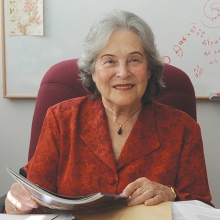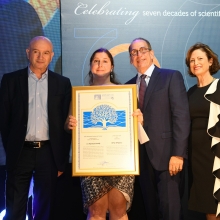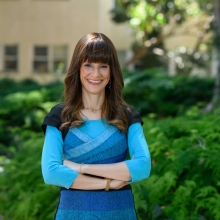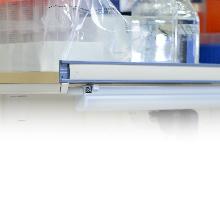The Nancy and Stephen Grand Israel National Center for Personalized Medicine
Q&A

Established in 2012 by the Weizmann Institute, the Nancy and Stephen Grand Israel National Center for Personalized Medicine (G-INCPM) is a state-of-the art research facility that provides Israeli academic, medical, and biomedical industry researchers with access to the most updated genomics, protein profiling, bioinformatics, drug discovery, and medicinal chemistry research platforms and know-how. The G-INCPM has the unique mandate to foster collaboration among basic research scientists and clinicians across Israel. The philosophy underlying the creation of G-INCPM has been to take advantage of the economies of scale created by a national entity available to all, and continuously invest in technological innovations to stay competitive in the rapidly changing field of life sciences.
Dr. Berta Strulovici is the Director of the G-INCPM, and rightly proud of its successes, observing that the number of projects undertaken has nearly doubled since 2014. She graciously answered our questions about the progress of this enterprise.
Q: How has the physical co-location of the various units in the G-INCPM affected productivity?
A: There has been a tremendously positive impact. We are witnessing a fully integrated, interdisciplinary enterprise that analyzes, synthesizes, and harmonizes links between disciplines as an efficient, coordinated, and coherent whole.
This interdisciplinary nature couldn’t have existed if we weren’t physically located together. For example, Dr. Liran Shlush from the Department of Immunology is studying acute myeloid leukemia (AML). He provided us with blood samples from AML patients and then, together with a physicianscientist at Assuta Medical Center, collaborated with G-INCPM by using all our platforms to determine how different patients responded to different drugs—and if so, what the basis of that difference was. If the units had been separate, it could have taken three years to get a result; here, we shared samples, equipment, and ideas and have been able to get things done a lot more quickly. Preliminary data appear quite encouraging. Such integration is rarely seen elsewhere, if at all.
In 2016, G-INCPM completed nearly 300 research projects with Weizmann Institute staff, as well as 145 research projects in collaboration with academic researchers from several external Israeli institutions, including the Hebrew University and the Technion. In addition, 23 projects were implemented with 31 physician-scientists from seven Israeli medical centers.
Q: What is the impact of all this activity on actual scientific advances and intellectual property?
A: We have contributed to more than 60 publications in high-impact journals and often, our team members serve as co-authors. In addition, they are co-authors of seven pending patent applications. We are very proud of these successes.
Q: What are some examples of new scientific activities?
A: The Crown Institute for Genomics in the G-INCPM has been developing in-house automated protocols for RNA analysis, for decreased cost and increased efficiency. Recently, it has begun implementing an analysis protocol that enables researchers to assess the expression of genes in single cells. This protocol will facilitate the discovery of numerous genomic indicators of disease risk. We foresee a high demand for it in labs across the country. In fact, we are in the process of creating an isolated ‘clean room’ lab within the Crown Institute, dedicated for this purpose.
With a surge in interest in applying mass spectrometry to proteomics research, the de Botton Institute for Protein Profiling invested in a new, stateof- the-art mass spectrometer. This new instrument enables faster and more sensitive analysis, and increased efficiency. Special capabilities include the analysis of post-translational modifications relevant to various disease states, with unprecedented sensitivity and precision. Given that this instrument is the only one of its kind in Israel, its unique capabilities as well as the tremendous technical knowledge the team has acquired confer a huge advantage on collaborators.
Through the efforts of the Ilana and Pascal Mantoux Institute for Bioinformatics and the G-INCPM IT Unit, an online portal has been built to allow scientists outside of G-INCPM to use the tools generated within the Center. Any collaborator will be able to track the progress of his or her project while it is being worked on, and download results and a qualitycontrol report.
The Compound Management Laboratory of the Maurice and Vivienne Wohl Institute for Drug Discovery recently completed the expansion of its compound library with the purchase of an additional 100,000 compounds with input from Pfizer chemists. These compounds should help ensure the Laboratory provides the best chemical materials for screening, to help identify “hits” through highthroughput screening (HTS).
Q: What will the new Medicinal Chemistry Unit do?
A: The HTS process performed in the Wohl Drug Discovery Institute is an important step towards identifying small molecules that may have the ability to modulate biological activity in live cells and in animal models of disease. However, although HTS provides primary “hits”, most are false positives, lacking the right pharmacological, biological, and toxicological properties necessary to validate novel biological hypotheses. Medicinal chemists then use the HTS hits as the starting point to design novel chemical matter with the “right” properties to serve as chemical probes for biological validation.
Pfizer is sending an experienced medical chemist to the G-INCPM every year for five years. The first is Dr. Bruce Lefker, who has 28 years of experience. He established the Medicinal Chemistry Unit and currently serves as its Acting Head.
Q: What is the future outlook for G-INCPM?
A: While the first five years were focused on building a national infrastructure, we predict that a natural shift will occur in the next five years, as we begin to focus on leveraging newly acquired knowledge and assets to create valued services and products. We are well on the way to creating value via translational research in collaboration with Israeli researchers.

Dr. Berta Strulovici








